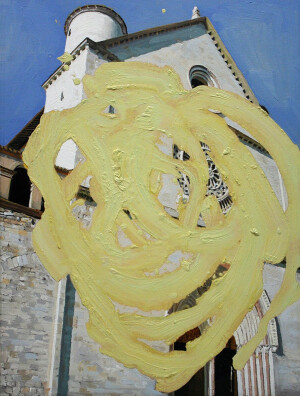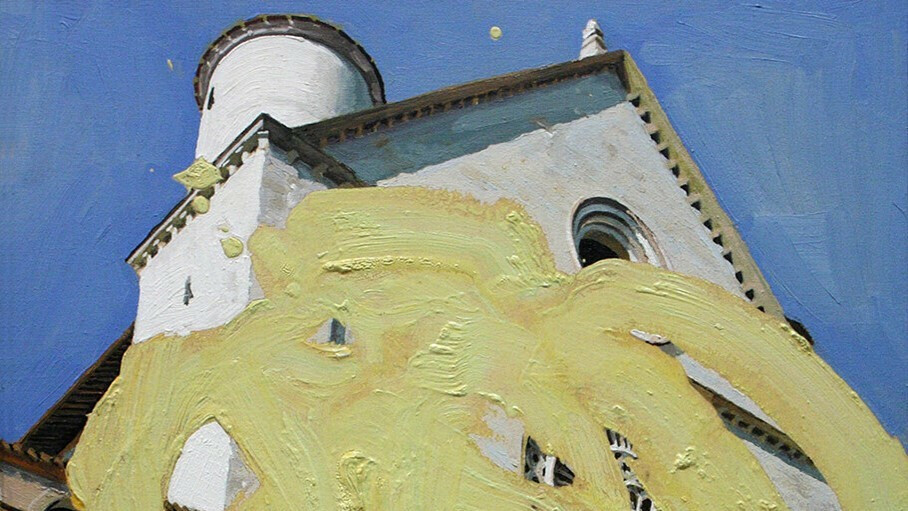TLDR: With a closer look, we often see something we missed at first glance. Lent helps us see things we have a tendency to overlook in life.

Jonathan Anderson. Impasse, 2007. Oil on panel. 16 x 12 inches.
Often, I like to share with you little treasures that may never cross your busy paths. Art is one of those things on many people’s ‘to do’ list to read more about and discover about this amazing world. I have heard some of you want to learn more about art but have remarked it takes precious amounts of time to unearth articles of substance. I found one such artist, Jonathan Anderson, that you may find intriguing. I often peruse the email teasers from Image online magazine when it appears in my already crowded inbox. Fair warning: to view Image is time consuming however it contains beautiful photography and provocative writing. I had a seminary professor who loved to use that word: provocative. According to Cambridge Dictionary, provocative means ‘causing thought about interesting subjects’. Therefore, Image art journal is extremely provocative by making one think deeper via the medium of art by the exploration of faith and by asking spiritual questions.
“Art, Faith, and Mystery” is the tag line above the Image logo when you click on their webpage. https://imagejournal.org/ That is exactly what this discovery is about-leaning into the mystery.
Image is a quarterly arts journal. According to their ‘about’ page, “Image is a lively community that gathers readers, writers, artists and art-appreciators in person and online.” Maybe you want to be a part of this community too? Just thought I would present you with this choice you may not have known you had.
Back to the artwork I discovered on Image. Anderson’s title piece of an entire series begins with the small painting titled, Impasse (2007). To save you time I looked up the meaning of Impasse. According to Oxford Dictionary the word means “a difficult situation in which no progress can be made because the people involved cannot agree what to do.” Artists love to play with the viewer by the titles they give their work. Anderson continues to confuse the viewer with the composition itself.
This piece appears to be a ruined painting which has been scribbled over by some vigorous vandalism. Yet upon more meticulous observation this “defacement” is in reality, the beginning point of the painting. W H A T???? Yes, that frothy, spiraling, sunny brushstroke was the first mark the artist chose to create on the blank wooden panel. Following those initial marks, the artist proceeded to paint the image which portrays the façade of the Basilica of Saint Francis of Assisi. Anderson painstakingly painted up and around and in between his initial yellow scrawl. I love it when artists fool the viewers into having second glances, deeper looks.
The yellow mess creates a barrier to the illusion of depth as the primary brushstrokes were not applied over a finished image; there is only a single layer of paint. In Anderson’s words:
“There are two orders of mark-making set alongside each other here,
each corresponding to a different visual logic—
one pertaining to the flatness of the material surface and
one to the pictorial depth and volume portraying the basilica.
We experience these two logics as competing with one another, even effacing each other,
but I’m interested in the ways that they reveal each other as different orders of meaning.”
Lent is like that for us. It can reveal modifications we may need to adjust or add new meanings by offering fresh perspectives. Sometimes we feel we experience an impasse of sorts. We get ourselves into difficult situations, emotionally or even spiritually, where we may not see much progress being made. The people involved in this case can be narrowed down to only us. At this impasse, we cannot agree what to do, how to feel, what to think, who to turn to with some of the questions lingering. Perhaps we enter the Lenten season full of scribbles in our life. Or experiencing a bit of messiness happening. That’s normal. That’s just life. Lent is a time to push the reset button. It can be a time of rest. It is a time to ask God to show us where we can make necessary changes. Lent asks of us to reflect on what is really going on inside. It’s time to get a bit more curious about the rumblings causing us to take a deeper look internally. Remember also that Lent is about the choices we make or rather have made. Oh, how we love our choices! I encourage you to go ahead choose to read between the lines (as in Anderson’s painting) and see the place where God’s at work. Christina Miller, a friend of mine who is the associate rector at St. James by the Sea, has a blog called Ordinary Liturgy. (I just love that name!) She wrote this about Lent,
“During Lent, Christians all over the world have the opportunity to re-focus our attention on God for forty days, preparing us for Holy Week. It is a time of spiritual realigning, so we can come together in our church communities to walk with Jesus in his suffering and receive his resurrection anew.”
So, what about you? What’s going on deep inside of you that God is quietly pointing out to you? What are the lines, those messy lines of your life that need something spiritual between them? Hmmm. With a closer look at the Anderson painting, one can see the brush strokes in between the scribble lines. How often do we appreciate something we missed at first glance? Lent helps us see things we tend to overlook.
Rev. Leesa+





